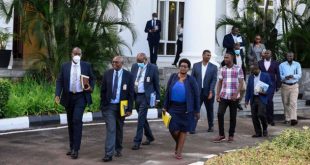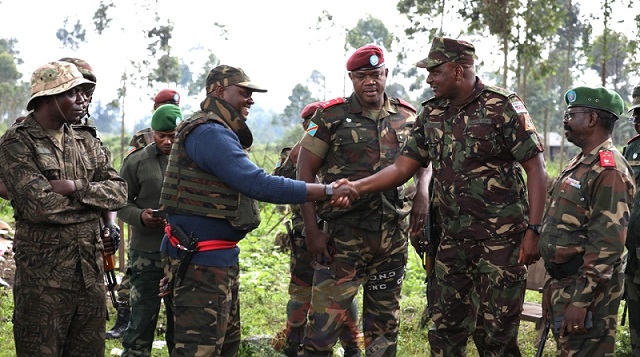
Can Uganda avoid Rwanda clash over M23?
COVER STORY | THE INDEPENDENT | East African heads of State convening for the African Union Summit in the Ethiopian capital, Addis Ababa, have put the renewed violence in the Democratic Republic of Congo (DR Congo) as the main agenda of their sidelines meeting.
For Ugandan President Yoweri Museveni, the main concern is ensuring that his army, the Uganda Peoples Defense Forces (UPDF) can continue on its Operation Shujaa – a peace and stability mission- without getting sucked into the politically charged confrontation with M23; the rebel group fighting the DR Congo government.
The current turmoil in DR Congo erupted in November 2021 when the March 23 Movement (M23) started attacking Congolese government forces in the North Kivu Province. The area is sensitive because it borders Uganda and Rwanda and has been a point of tension and fighting between otherwise friendly neighbours.
Although relations between them have been warming since Rwanda re-opened their common border in January 2022 after closing it for three years, President Paul Kagame is said to be unhappy about DR Congo’s decision to lock it out of East African armies allowed to deploy in the area.
DR Congo President, Felix Tshisekedi in 2021 invited the UPDF to make limited incursions into its territory in pursuit of the Allied Democratic Forces (ADF); a mostly Ugandan rebel group that uses the eastern DR Congo as its rear base.
The UPDF incursion occurred soon after Museveni accused the ADF, which is said to have become an Islamic State franchise in 2019, of launching two deadly suicide bombings in Kampala in Nov.2021.
Rwanda argues that the DR Congo should have allowed it to enter its territory in hot pursuit of the Forces Démocratiques de Libération du Rwanda (FDLR); an evolving militia associated with remnants of forces responsible for the 1994 genocide that fled there when the Rwanda Patriotic Front (RPF) captured power. Rwanda regards the FDLR as an existential threat.
Recent M23 attacks escalated in May 2022, when the rebellion captured Rumangabo, the largest army camp in North Kivu, and advanced toward Goma. By the end of May, 61,000 people had been displaced, while accusations emerged that the Rwandan government was backing the M23 offensive.
President Tshisekedi is among those accusing Kagame of supporting the M23 rebels whose rank and file are Congolese citizens with ancient ethnic connections to Rwanda.
Rwanda denies arming the M23 and insists the Congolese government should let stabilization forces enter because it has failed to establish control and eliminate the myriad rebel groups.
Amid rising tensions, the Rwandan army on Jan.24 fired a missile at a Congolese warplane. Both Rwanda and the DR Congo are members of the East African Community (EAC) which is engaging in various maneuvers to ensure a return to normalcy.
Diplomatic efforts
On the diplomatic front, efforts to stabilize eastern DR Congo appear to be disjointed.
The first and most important effort appears to be the Luanda Round of Talks involving heads of state of countries in the International Conference on the Great Lakes Region (ICGLR), which comprises 12 member states, namely: Angola, Burundi, Central African Republic, Republic of Congo, Democratic Republic of Congo, Kenya, Uganda, Rwanda, Republic of South Sudan, Sudan, Tanzania and Zambia.
The second initiative is being pushed by the EAC heads of state. Their latest meeting was in the Burundian capital Bujumbura on Feb.04. The 20th Extra-Ordinary Summit of EAC Heads of State was attended by all heads of State except Salva Kirr of South Sudan and, among other resolutions, called for an immediate ceasefire, dialogue, withdrawal of all armed foreign groups, and immediate deployment by all troop contributing countries. It directed the Chiefs of Defence forces to convene within a week to draw up a matrix of redeployment.
The third are the Nairobi talks convened by the immediate former Kenyan President Uhuru Kenyatta. These have involved many important armed groups in eastern DR Congo and Congolese officials. But M23 has been locked out on the insistence of President Tshisekedi.
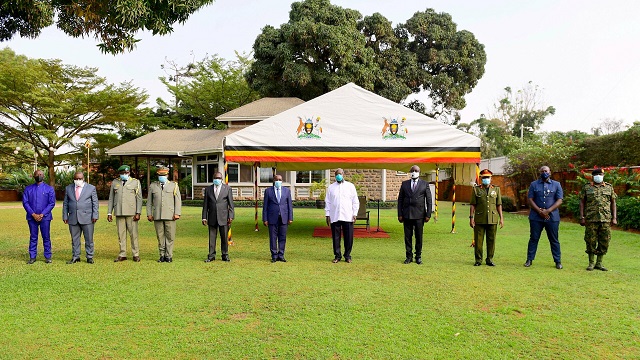
Experts have argued that since it is unlikely that any of these initiatives can give way, a superior tack of negotiations could be arranged by the African Union (UN) to try to ensure that the different efforts are synced up and consistent in their aims.
Military deployment
Deployment of regional forces to ensure M23 abides by the EAC agreed position on the conflict and is blocked from further military advances by a buffer between it and DR Congo forces is a major maneuver. Under this arrangement, Uganda appears to have opted for areas closer to its Operation Shujaa zone.
When Rwanda sought to join the new force put in place in the course of 2022 by the East Africa Community (EAC) regional bloc to fight insurgents, it was rebuffed by the DR Congo government. To press its point, Kinshasa in late January expelled Rwandan staff officers working at the forces’ headquarters. The force comprises Ugandan, Burundian, South Sudanese and Kenyan troops.
But one report has described the East Africa Community Regional Force (EACRF) as a “disparate and little-coordinated force.”
According to reports, a meeting of the defense chiefs of EAC militaries agreed on a deployment format that could see regional forces peacefully occupy the areas previously held by M23 as part of a speedy withdrawal and demobilization of guerrilla elements in the east from the DRC.
According to information, M23 fighters have until March 10 to withdraw from Karenga, Kilolirwe, Kitchanga, Kibumba and Rumangabo.
Ten days later, by March 20, they must have left Kishishe, Bambo, Kazaroho, Tongo and Mabenga. The last phase of the withdrawal of the M23 elements will take place on March 30, with their departure from Rutshuru, Kiwanja and Bunagana.
After the effective withdrawal of M23 from the occupied areas, the Uganda army will take control of Bunagana, Kiwanja and Mabega; the Burundian army will occupy the towns of Sake, Kilolirwe and Kitchanga, and the South Sudanese and Kenyan armies will take up positions in Rumangabo, while Kenyan forces will take up positions in Kibumba, Tongo, Bwiza and Kishishe.
Uganda’s deployment in Bunagana, Kiwanja/Rutshuru and Mabenga could be for military expedience as it means a revision of scope for the forces without a major shift in mission. But it could be a diplomatic ploy to ensure that the Uganda army is not sucked into a hot war between the DR Congo forces on one side and the Rwanda army and M23 rebels on the other.
President Museveni has a long historic connection to the M23 and has in the past been accused of supporting them militarily by the DR Congo government. Museveni has always refuted the allegations and insisted instead the DR Congo government and M23 settle their disputes politically rather than militarily. President Tshisekedi has consistently refused to hold peace talks with the M23.
President Museveni, who also has a deep historical relationship and has invested heavily in courting Rwanda, is walking on slippery ground because the DR Congo which has always been an important trading partner of Uganda acquired even greater status when it became a member of the EAC on March 29, 2022.
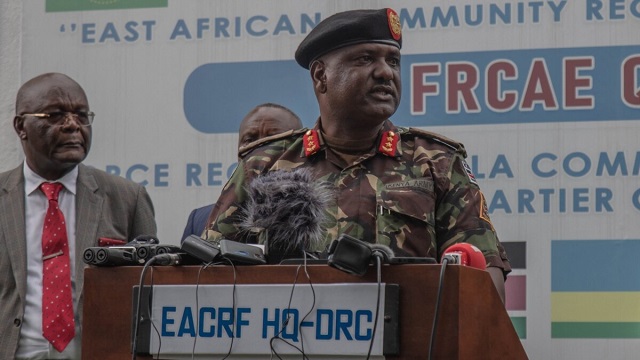
Uganda’s formal exports to Congo, which stood at US$156 million in in 2019 are likely to grow under the new arrangement. The informal exports which were even greater, worth US$330 million, are likely to become even bigger. There is double attraction for Museveni who is trying to grow Uganda’s manufacturing sector because the majority of exports to DR Congo are industrial goods. Congo has a much weaker manufacturing sector and imports many agricultural goods from Uganda. DR Congo’s integration into the EAC is expected to further expand this market for Ugandan products.
But Stewart Muhindo Kalyamughuma, a Congolese researcher and activist affiliated with LUCHA, a nonviolent, nonpartisan civil society movement, is suspicious of Uganda controlling Bunagana and Rutshuru which are near Uganda.
“It means that they can control Congolese resources and they have the freedom to get in and take out of Congo without Congolese oversight,” he says.
“This is the same with Burundi, which is going to control the Masisi territory and South Kivu which is near its border,” he adds, “What we want is for Congo to build its security system and not continue depending upon other countries.”
War is inevitable
Kalyamughuma says when the presidents of the International Conference on the Great Lakes Region (ICGLR), signed an agreement in Luanda, they re-affirmed their decision that if M23 does not leave Congolese territory, they would have to be attacked by an East African Community Regional Force (EACRF).
He says even when the EACRF arrived, they said they have “an offensive mandate meaning that they will fight against M23.” But he says, today the EACRF appears to be helping M23.
“For example, in Kibumba and Rumangabo, M23 said they had left those zones for the EACRF but up to now the rebels are still grounded in those areas together with EACRF. It’s like the two forces are working together instead of the EACRF working with the Congolese army.
“What the Congolese want is for the EACRF to do what they promised they would do if M23 do not leave. If they are unable to fight, they should leave Congo and return to their countries,” he says.
He describes how before the EACRF arrived, the Congolese soldiers were doing a good job fighting the M23. He said M23 who were about 30km from Goma had been repulsed.
“I am not sure the EAC initiative will bring peace in eastern DR Congo. This is because states like Uganda, Rwanda and Burundi are at the centre of destabilization of Congo. They have perpetrated many crimes against Congolese people for which the victims are yet to get justice.
“We know that Rwanda, Burundi and Uganda continue to have a bad agenda against our country. When we see the Nairobi Process, we think that it’s dangerous to say that other countries will control parts of our country.
Pecos Kulihoshi Musikami, a resident of Goma, in North Kivu Province, says many Congolese do not trust that negotiations with M23 will yield much.
“The only problem we have in eastern DR Congo is M23,” says Musikami.
“They came in 1996 under Laurent Kabila with the intention of capturing DR Congo; it didn’t work. In 1998, they came with different rebel group. They kept up with the incursions only changing the colour of their military fatigues,” he told The Independent, “Unfortunately, since 1996 up to now, we have been involved in long winding negotiations but these negotiations have not taken us anywhere.”
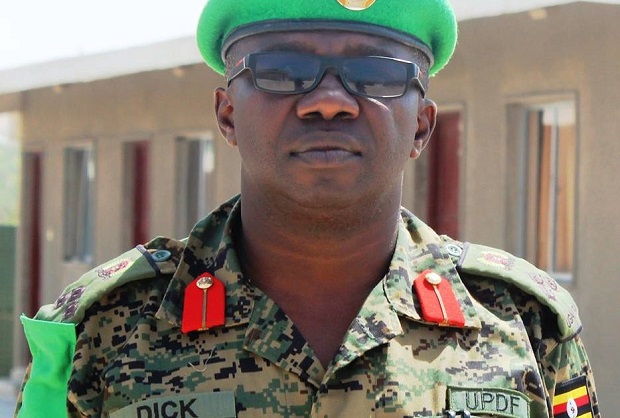
He describes how the forces behind M23 have morphed over time. In 1996, they came as liberators with Laurent Kabila; in 1998, they came with RCD-Goma and MLC of Jean Pierre Bemba. In 2003, they came with a different scenario, morphed again and in 2008, they came back under Laurent Nkunda. In 2011, they came again under M23 which is still active now.
“So, the issue is not that the Congolese are impatient; the issue is that all of us have to accept that this instability has gone on for so long and it cannot continue like this and we must therefore put an end to it,” he says.
He says what the Congolese people want is for the M23 to be “vanquished militarily in Rutshuru.”
“DR Congo must ensure that they don’t get sheltered in Uganda and Rwanda,” he adds, “Once this is done, then eastern DR Congo will be totally peaceful. You will never hear any idea of war in eastern DR Congo.”
Musikami dismisses claims that rebel activity thrives because the Congolese government lacks a presence in eastern DR Congo.
“Why is it that it is in these regions neighbouring Rwanda and Uganda,” he asks.
According to him, the Congolese are suspicious of the East African Community Regional Force (EACRF): “Uganda has been highly involved in the violence in Congo since 1996 and the Congolese don’t think a solution will come from Uganda,” he says.
“Rwanda is the godfather of M23 and a solution cannot come from there(either),” he adds.
“The only thing the Congolese want the EACRF to do is launch a war against the M23 to defeat decisively,” he says, “Unfortunately, the EACRF did not come with that agenda, it came with the agenda of peace keeping and of negotiating but negotiate about what? Truly speaking, the fundamental understanding of the mission of the EACRF is totally different.
“We don’t want people who are going to massage M23, we want people who are going to attack and defeat them once and for all. We have been on the negotiating table for a long time and these negotiations have not borne any tangible results.”
*****
**Additional reporting by Ronald Musoke
 The Independent Uganda: You get the Truth we Pay the Price
The Independent Uganda: You get the Truth we Pay the Price

